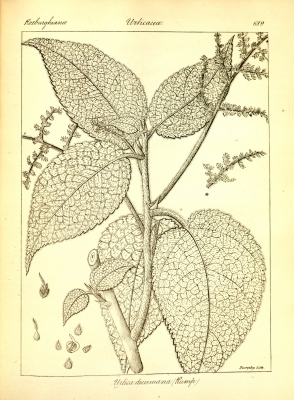Laportea decumana
(Roxb.) Wedd.
Urticaceae
Urtica decumana Roxb.
Urticastrum decumanum (Roxb.) Kuntze
Common Name:
General Information
Laportea decumana is a perennial plant with stems that become more or less woody and can persist for several years. It can grow up to 2 metres tall, the well-branched stems and leaves densely armed with irritant hairs[
310- Title
- Plant Resources of Southeast Asia
- Publication
-
- Author
-
- Website
- http://proseanet.org/
- Publisher
-
- Year
- 0
- ISBN
-
- Description
- Lots of information on the uses of the plants of SE Asia.
].
The plant is harvested from the wild for local medicinal use. It is cultivated locally for medicinal purposes in the Moluccas and in New Guinea[
310- Title
- Plant Resources of Southeast Asia
- Publication
-
- Author
-
- Website
- http://proseanet.org/
- Publisher
-
- Year
- 0
- ISBN
-
- Description
- Lots of information on the uses of the plants of SE Asia.
].
Known Hazards
The plant is densely armed with irritant hairs[
310- Title
- Plant Resources of Southeast Asia
- Publication
-
- Author
-
- Website
- http://proseanet.org/
- Publisher
-
- Year
- 0
- ISBN
-
- Description
- Lots of information on the uses of the plants of SE Asia.
]. The leaves have stinging hairs, much like stinging nettles (Urtica species) to which they are related[
407- Title
- BoDD (Botanical Dermatology Database)
- Publication
-
- Author
-
- Website
- http://bodd.cf.ac.uk/
- Publisher
-
- Year
- 0
- ISBN
-
- Description
- Brief notes on a very wide range of plants that have reports of causing harm to the skin.
].
Botanical References
Range
Southeast Asia - Indonesia from southern Borneo east to New Guinea
Habitat
Common in forest margins and as undergrowth in hedges at low elevations[
310- Title
- Plant Resources of Southeast Asia
- Publication
-
- Author
-
- Website
- http://proseanet.org/
- Publisher
-
- Year
- 0
- ISBN
-
- Description
- Lots of information on the uses of the plants of SE Asia.
]. It prefers shady places and is often found in wet but well-drained soils[
481- Title
- Medicinal Plants in Papua New Guinea
- Publication
-
- Author
-
- Publisher
- World Health Organisation
- Year
- 2009
- ISBN
- 978-92-9061-249-0
- Description
- Traditional medicinal uses of 126 species from Papua New Guinea, including information on modern research into the plants.
].
Properties
| Medicinal Rating |      |
| Habit | Shrub |
| Height | 1.50 m |
| Cultivation Status | Cultivated, Wild |
Cultivation Details
Prefers a shady position[
481- Title
- Medicinal Plants in Papua New Guinea
- Publication
-
- Author
-
- Publisher
- World Health Organisation
- Year
- 2009
- ISBN
- 978-92-9061-249-0
- Description
- Traditional medicinal uses of 126 species from Papua New Guinea, including information on modern research into the plants.
]. Grows well in wet but well-drained soils[
481- Title
- Medicinal Plants in Papua New Guinea
- Publication
-
- Author
-
- Publisher
- World Health Organisation
- Year
- 2009
- ISBN
- 978-92-9061-249-0
- Description
- Traditional medicinal uses of 126 species from Papua New Guinea, including information on modern research into the plants.
].
Edible Uses
None known
Medicinal
Fresh young leaves are eaten with sweet potato or taro as a remedy for intestinal pains[
310- Title
- Plant Resources of Southeast Asia
- Publication
-
- Author
-
- Website
- http://proseanet.org/
- Publisher
-
- Year
- 0
- ISBN
-
- Description
- Lots of information on the uses of the plants of SE Asia.
]. (It can be assumed that, in common with other members of this plant family, the irritant hairs are neutralized by heat[
K- Title
- Plants for a Future
- Author
- Ken Fern
- Description
- Notes from observations, tasting etc at Plants For A Future and on field trips.
])
The leaves are rubbed or gently stroked on various parts of the body in order to counteract fever, body pains, fatigue, stomach-ache and headaches[
310- Title
- Plant Resources of Southeast Asia
- Publication
-
- Author
-
- Website
- http://proseanet.org/
- Publisher
-
- Year
- 0
- ISBN
-
- Description
- Lots of information on the uses of the plants of SE Asia.
]. A leaf with its lower surface held towards the body is used - a stinging sensation is felt as the treatment commences, but numbness and anaesthesia develop as the treatment progresses[
481- Title
- Medicinal Plants in Papua New Guinea
- Publication
-
- Author
-
- Publisher
- World Health Organisation
- Year
- 2009
- ISBN
- 978-92-9061-249-0
- Description
- Traditional medicinal uses of 126 species from Papua New Guinea, including information on modern research into the plants.
].
Other Uses
None known
Propagation
Seed -
If you have any useful information about this plant, please leave a comment. Comments have to be approved before they are shown here.


 Useful Tropical Plants Database 2014 by
Ken Fern,
web interface by
Ajna Fern
with help from
Richard Morris.
Useful Tropical Plants Database 2014 by
Ken Fern,
web interface by
Ajna Fern
with help from
Richard Morris.